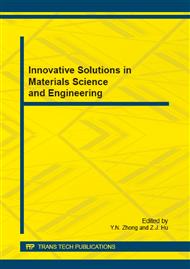[1]
Appendini P, Hotchkiss J H. Review of antimicrobial food packaging. Innovative Food Science& Emerging Technologies, 2002, 3(2): 113-126.
DOI: 10.1016/s1466-8564(02)00012-7
Google Scholar
[2]
Yu BY, Leung KM, Guo QQ, Lau WM, Yang J. Synthesis of Ag-TiO2 composite nano thin film for antimicrobial application. Nanotechnology, 2011, 22(11): 47-84.
DOI: 10.1088/0957-4484/22/11/115603
Google Scholar
[3]
Bruna JE, Galotto MJ, Guarda A, Rodríguez F. A novel polymer based on MtCu2+/cellulose acetate with antimicrobial activity. Carbohydrate Polymers, 2014, 102(2): 317-323.
DOI: 10.1016/j.carbpol.2013.11.038
Google Scholar
[4]
Suppakul P, Miltz J, Sonneveld K, et al. Characterization of antimicrobial films containing basil extracts. Packaging Technology and Science, 2006, 19(5): 259-268.
DOI: 10.1002/pts.729
Google Scholar
[5]
Tripathi S, Mehrotra GK, Dutta PK. Physicochemical and bioactivity of cross-linked chitosan–PVA film for food packaging applications. International Journal of Biological Macromolecules, 2009, 45(4): 372-376.
DOI: 10.1016/j.ijbiomac.2009.07.006
Google Scholar
[6]
Broumand A, Djomeh ZE, Hamedi M, Razavi SH. Antimicrobial, water vapour permeability, mechanical and thermal properties of casein based Zataraia multiflora Boiss. Extract containing film. LWT-Food Science and Technology, 2011, 44(10): 2316-2323.
DOI: 10.1016/j.lwt.2011.07.002
Google Scholar
[7]
Sanchez-Garcia MD, Ocio MJ, Gimenez E, Lagaron JM. Novel polycaprolactone nanocomposites containing thymol of interest in antimicrobial film and coating applications. Journal of Plastic Film and Sheeting, 2008, 24: 239-251.
DOI: 10.1177/8756087908101539
Google Scholar
[8]
Chunxu Dong, John Cairney, Qunhui Sun, etal. Investigation of Mg(OH)2 nanoparticles as an antibacterial agent. J Nanopart Res, 2010, 12: 2101-2109.
DOI: 10.1007/s11051-009-9769-9
Google Scholar
[9]
Yoshinari M, Oda Y, Kato T, etal. Influence of surface modifications to titanium on antibacterial activity in vitro. Biomaterials, 2001, 22: 2043-(2048).
DOI: 10.1016/s0142-9612(00)00392-6
Google Scholar
[10]
Ming Fang, Feng Chai, Ji-Hua Chen, Christel Neut, Min Jia, Yi Liu, San-Jun Zhao, Hartmut F. Hildebrand. Antibacterial functionalization of an experimental self-etching primer by inorganic agents: Microbiological and biocompatibility evaluations. Biomolecular Engineering, 2007, 24(5): 483-488.
DOI: 10.1016/j.bioeng.2007.07.013
Google Scholar
[11]
Ming Fang, Ji-Hua Chen, Xiu-Li Xu, Pei-Hong Yang, Hartmut F, Hildebrand. Antibacterial activities of inorganic agents on six bacteria associated with oral infections by two susceptibility tests. International Journal of Antimicrobial Agents, 2006, 27(6): 513-517.
DOI: 10.1016/j.ijantimicag.2006.01.008
Google Scholar
[12]
QB/T 2591-2003 Antimicrobial plastics—Test for antimicrobial activity and efficacy. The People's Republic of China light industry standard, The national development and reform commission of the People's Republic of China, (2003).
Google Scholar
[13]
ASTM D882-02 Standard Test Method for Tensile Properties of Thin Plastic Sheeting. Annual Book of ASTM Standards, Volume 08. 01, ASTM International: West Conshohocken, PA, (2010).
Google Scholar
[14]
ASTM D1004-07 Standard Test Method for Tear Resistance (Graves Tear) of Plastic Film and Sheeting. Annual Book of ASTM Standards, Volume 08. 01, ASTM International: West Conshohocken, PA, (2010).
DOI: 10.1520/d1004-07
Google Scholar
[15]
ASTM D1003-07E01 Test Method for Haze and Luminous Transmittance of Transparent Plastics. Annual Book of ASTM Standards, Volume 08. 01, ASTM International: West Conshohocken, PA, (2010).
Google Scholar


